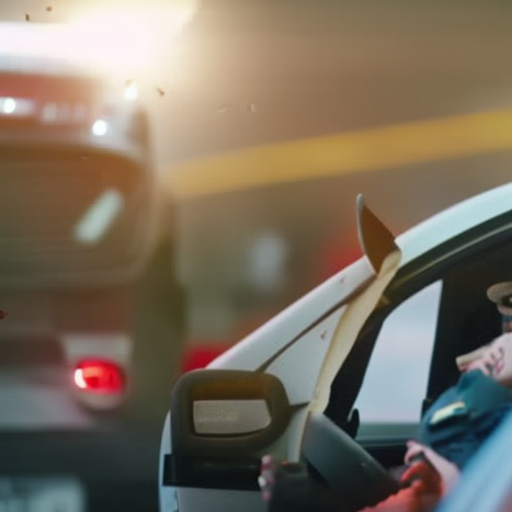"Cherishing Little Steps - A Haven for Baby and Family Journeys"
Car Seat Safety Myths Debunked
Hey there, parent! Buckle up and get ready to debunk some car seat safety myths.
Picture this: you’re driving down the road, your little one safely strapped into their car seat. But are you sure you’re doing everything right? There’s so much conflicting information out there, it can be overwhelming.
Well, worry no more. In this guide, we’re going to separate fact from fiction and set the record straight. From the importance of rear-facing for longer to the truth about bulky winter coats, we’ll cover it all.
So, let’s dive in and learn the truth about car seat safety. You’ll feel empowered and confident, knowing you’re doing everything you can to keep your little one safe on the road.
Key Takeaways
- Rear-facing car seats provide the best protection in a crash, reducing the risk of head, neck, and spine injuries.
- The 2-Hour Rule states that a child should not spend more than two consecutive hours in a car seat without a break.
- Using both the LATCH system and seat belt for car seat installation is not recommended, and both methods are equally safe when installed correctly.
- Aftermarket products for car seats are not tested or regulated for safety, and using them can compromise the effectiveness of the car seat and increase the risk of injury.
Rear-Facing for Longer
In the article, you’ll learn why it’s important for you to keep your child rear-facing for longer in their car seat. Extended rear facing is a practice that aligns with the current safety standards and guidelines for child passenger safety. Research has shown that rear-facing car seats provide the best protection for young children in the event of a crash.
By keeping your child rear-facing for as long as possible, you’re minimizing the risk of serious injuries to their head, neck, and spine. The extended rear-facing position allows the car seat to absorb most of the crash forces, reducing the impact on your child’s fragile body.
Safety standards recommend that children should remain rear-facing until at least the age of 2, but it’s even better to keep them in this position until they reach the maximum height and weight limits of their car seat. This ensures that they’re adequately protected in the event of a collision.
It is important to note that rear-facing car seats are designed to accommodate the growth and development of your child. They provide a snug fit and proper support, allowing your child to sit comfortably while maintaining optimal safety.
The 2-Hour Rule
Make sure to adhere to the 2-Hour Rule when it comes to car seat safety. This rule is especially important during long trips or in extreme weather conditions. To ensure your child’s safety, it is crucial to follow this guideline.
The 2-Hour Rule states that a child should not spend more than two consecutive hours in a car seat without taking a break. This rule applies to infants and toddlers alike. Prolonged periods in a car seat can put your child at risk for various health issues, such as restricted breathing, poor circulation, and discomfort.
To help you understand the importance of the 2-Hour Rule, here is a table that illustrates the potential risks associated with prolonged car seat use:
| Risk | Consequence |
|---|---|
| Restricted Breathing | Lack of oxygen, potential respiratory problems |
| Poor Circulation | Reduced blood flow, potential blood clots |
| Discomfort | Muscle stiffness, potential pressure sores |
| Overheating (in hot weather) | Hyperthermia, dehydration |
Buckling up With Bulky Clothing
When it comes to car seat safety, it’s important to avoid wearing bulky clothing while buckling up. Proper car seat harnessing is crucial to ensure the safety of your child in the event of an accident. Loose clothing can have a negative impact on car seat performance and compromise the effectiveness of the harness. Here are three reasons why you should avoid wearing bulky clothing when buckling up:
-
Reduced harness effectiveness: Bulky clothing, such as puffy jackets or snowsuits, can create a gap between the child and the harness straps. This gap can prevent the harness from properly restraining the child during a crash, increasing the risk of injury.
-
Slipping out of the harness: Loose clothing can cause the harness straps to become loose or twisted, making it easier for your child to slip out of the car seat during a collision. This puts them at a higher risk of being ejected from the seat and suffering serious injuries.
-
Increased crash forces: When bulky clothing is compressed during an impact, it can create extra space between the child’s body and the car seat. This additional space allows for greater movement during a crash, which can increase the forces exerted on your child’s body and potentially cause more severe injuries.
To ensure your child’s safety, dress them in thin layers and remove any bulky clothing before buckling them into their car seat. This will help maintain proper harness fit and maximize the effectiveness of the car seat in protecting your child.
Car Seat Expiration Dates

Check the expiration date on your car seat to ensure its safety and effectiveness. Car seat expiration dates are an essential factor in car seat maintenance and play a crucial role in car seat regulations. Just like other products, car seats have a limited lifespan due to wear and tear, exposure to various elements, and advances in safety technology. It’s important to note that car seat manufacturers determine the expiration date based on rigorous testing and research.
Expired car seats may not provide the same level of protection as newer models. Over time, the materials used in car seats can degrade, compromising their structural integrity. Additionally, safety standards and regulations are constantly evolving, and older car seats may not meet the latest requirements.
To find the expiration date on your car seat, check the manufacturer’s label or manual. It’s recommended to replace the car seat once it reaches its expiration date. Using an expired car seat puts your child at unnecessary risk in the event of a crash.
Boosters Vs. Seat Belts
To ensure optimal safety and protection for your child, it’s crucial to understand the differences between boosters and seat belts. Here are three key points to consider:
-
Boosters:
- Pros: Boosters provide a raised seating position, allowing the seat belt to fit properly across your child’s body. They also offer additional support and comfort during long car rides.
- Cons: Boosters may not be suitable for all children, particularly those who are too small or too young to sit in a booster. Additionally, boosters can be bulky and cumbersome to install and remove from the car.
-
Seat Belts:
- Pros: Seat belts are designed to protect adults and older children. They’re simple to use and require no additional installation or adjustment. Seat belts are also more cost-effective compared to boosters.
- Cons: Seat belts may not provide adequate protection for younger children who haven’t yet reached the recommended height and weight requirements. They can also be uncomfortable for children who are too small to properly fit the seat belt across their body.
In terms of effectiveness in preventing injuries, both boosters and seat belts are important tools for child passenger safety. However, it’s essential to choose the appropriate option based on your child’s age, height, and weight.
LATCH System Myths

Have you ever wondered if the LATCH system in your car seat is as secure as you think it is? It’s time to debunk some LATCH system myths and ensure that you’re installing your car seat correctly.
The LATCH system, which stands for Lower Anchors and Tethers for Children, is designed to make car seat installation easier and more secure. However, there are a few misconceptions surrounding its usage.
Firstly, many parents believe that using both the LATCH system and the seat belt for installation provides extra safety. However, this isn’t recommended by car seat manufacturers. It’s important to choose one method of installation and follow the manufacturer’s guidelines.
Another myth is that the LATCH system is always safer than using the seat belt. While the LATCH system is convenient and secure, it’s important to remember that both methods are equally safe when installed correctly. It’s crucial to follow the car seat manufacturer’s guidelines for proper installation.
Installing Car Seats Correctly

Make sure you properly secure your car seat by correctly fastening it to the vehicle. Installing car seats incorrectly can greatly reduce their effectiveness in protecting your child in the event of an accident. Here are some common car seat installation mistakes to avoid:
-
Loose installation: One of the most common mistakes isn’t tightening the seat properly. The car seat shouldn’t move more than an inch in any direction when tested at the base.
-
Incorrect angle: It’s important to ensure that the car seat is installed at the correct recline angle. Follow the manufacturer’s instructions to find the appropriate angle for your child’s age and weight.
-
Incorrect use of seat belts or LATCH system: Using the wrong belt path or not properly securing the car seat with the LATCH system can compromise its safety. Always refer to the car seat and vehicle manual to ensure correct installation.
To ensure your child’s safety, take the time to carefully read the car seat and vehicle manuals, and follow the instructions for installation. If you’re unsure about the correct installation, seek help from a certified car seat technician.
The Myth of Used Car Seats

Securing your child’s safety in a car seat involves understanding the myth surrounding used car seats. Many parents believe that they can sell or buy a used car seat without any concerns. However, this is a dangerous misconception. Selling used car seats can put another child’s safety at risk, while buying one may compromise your own child’s safety.
Car seat safety regulations are constantly evolving and improving. Older car seats may not meet the current safety standards or have been involved in accidents, making them less effective in protecting your child. Additionally, car seats have an expiration date, usually around six years after their manufacturing date. This is because the materials can degrade over time, reducing their ability to protect your child in the event of a crash.
It is crucial to follow the manufacturer’s instructions regarding the lifespan of a car seat and to never use one that has been involved in an accident. When selling a car seat, it’s important to disclose its history to the buyer to ensure they’re aware of any potential risks.
Air Travel and Car Seat Safety
Ensure your child’s safety during air travel by understanding the guidelines for car seat use. When it comes to flying with your little one, it’s important to know the rules and regulations set by the Federal Aviation Administration (FAA). Here are three key things to keep in mind:
-
Child Safety Devices: The FAA strongly recommends using an approved child safety device, such as a car seat, for children under the age of 2. These devices provide an added layer of protection during the flight, ensuring that your child is secure and comfortable. Make sure to choose a car seat that’s approved for use on aircraft, as not all car seats meet the FAA’s requirements.
-
FAA Regulations: It’s crucial to follow the FAA’s guidelines when using a car seat on an airplane. The seat must be properly installed and secured in its own seat, typically in a window seat or in a row with no emergency exit. Additionally, the car seat should be labeled with an FAA-approved sticker or label, indicating that it meets the necessary safety standards.
-
Advance Planning: It’s important to plan ahead and inform the airline that you’ll be bringing a car seat on board. Some airlines may require you to provide certain information or make arrangements in advance. By being prepared, you can ensure a smooth and safe journey for your child.
Car Seat Positioning in the Vehicle
To maximize your child’s safety in the vehicle, it’s important to understand the proper positioning of the car seat. One common misconception is that front-facing car seats offer better protection. However, research shows that rear-facing car seats are actually the safest option for young children. In a front-facing position, the force of a crash is concentrated on the child’s head and neck, which can result in severe injuries. On the other hand, rear-facing car seats distribute the force of impact over the child’s entire body, reducing the risk of injury.
Another crucial aspect of car seat positioning is side impact protection. Side collisions account for a significant number of car accidents, and it’s important to have proper measures in place to protect your child. Some car seats come equipped with additional side impact protection features, such as energy-absorbing foam and reinforced headrests. These features help to cushion the impact and minimize injuries in the event of a side collision. When installing the car seat, make sure it’s securely fastened and positioned away from doors and windows to provide maximum protection.
The Safety of Aftermarket Products

One common myth to debunk is that using aftermarket products will enhance the safety of your child’s car seat. In reality, these aftermarket products can actually compromise the safety of your child and should be avoided. Here are three reasons why:
-
Compatibility: Car seats are rigorously tested and designed to work seamlessly with specific vehicles. Aftermarket products, such as car seat accessories, may not be compatible with your car seat model, compromising its overall effectiveness in a crash.
-
Proper Installation: Installing a car seat correctly is crucial for your child’s safety. Aftermarket products may interfere with the proper installation of the car seat, making it difficult to achieve a secure fit. This can increase the risk of the car seat being improperly installed, putting your child at risk in the event of an accident.
-
Crash Performance: Car seats undergo extensive testing to ensure they provide optimal protection in the event of a crash. Aftermarket products haven’t been tested alongside the car seat and may interfere with the car seat’s ability to perform as intended during an accident.
To ensure the safety of your child, it’s best to stick with the accessories and products that are specifically designed and approved by the car seat manufacturer. Remember, it’s always better to prioritize safety over convenience when it comes to your child’s car seat.
Car Seat Safety and Emergency Situations

In case of an emergency, safely securing your child in their car seat is of utmost importance. Whether you find yourself in a water or fire emergency, knowing how to protect your child properly is crucial. Here are some key points to remember when it comes to car seat safety in these situations:
Car Seat Safety and Water Emergencies:
- If your vehicle is submerged in water, it’s essential to act quickly but calmly.
- Unbuckle your child from their car seat and keep them close to you as you exit the vehicle.
- If you’re unable to unbuckle your child, don’t waste time trying to unbuckle them. Instead, hold their head above water and exit the vehicle together.
Car Seat Safety and Fire Emergencies:
- In the event of a fire, time is of the essence.
- Safely remove your child from their car seat as quickly as possible.
- If your child’s clothing is on fire, remember to stop, drop, and roll to extinguish the flames.
Frequently Asked Questions
Are There Any Specific Safety Guidelines for Car Seat Positioning in the Vehicle?
When it comes to car seat positioning in your vehicle, it’s important to follow specific safety guidelines. Make sure to install your car seat properly and adhere to best practices for optimal protection.
What Are Some Common Myths About the LATCH System?
You may have heard some things about the LATCH system, but let’s set the record straight. Here are some common myths: LATCH system installation tips and weight limits. Don’t be fooled!
Is It Safe to Use Aftermarket Products With Car Seats?
Using aftermarket products with car seats can be risky. These products are not tested or regulated, compromising the safety of the car seat. Additionally, it’s important to note that car seats have expiration dates, so using an expired seat is unsafe.
How Do Emergency Situations Affect Car Seat Safety?
During emergency situations, it’s important to consider how they impact car seat safety. The force of sudden stops or collisions can endanger your child’s safety, so always ensure your car seat is properly installed and secured.
Can I Use a Used Car Seat if It Is in Good Condition?
You may wonder if a used car seat in good condition is safe, but it’s always better to buy a new one. The benefits of buying a new car seat include ensuring the highest level of safety for your child.
Conclusion
In conclusion, it’s essential to separate fact from fiction when it comes to car seat safety. By debunking common myths, we can ensure that children are protected on the road.
Remember, keeping your child rear-facing for longer is like wrapping them in a protective cocoon, safeguarding them from harm.
Don’t let misconceptions put your child at risk; follow the guidelines and make informed choices for their safety.


